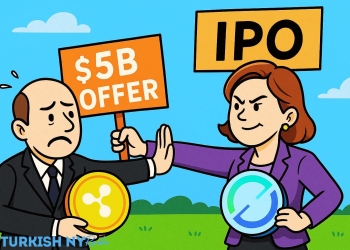CVault.finance (CORE) is a DeFi protocol that offers users the opportunity to stake their deflationary governance token, CORE, and earn yields through farming. The platform’s roadmap includes the development of “Automated Strategy Vaults,” which will enable the automatic execution of profit-generating strategies for staked tokens.
The governance model of cVault.finance is completely decentralized, and the platform claims that its approach is the strongest and most involved in DeFi. As a community, CORE token holders can vote on changes to the protocol, such as the creation or elimination of liquidity pools.
CVault.finance was launched on the Ethereum mainnet in September 2020, with CORE being listed on Uniswap just seven days later.
cVault.finance’s Unique Approach to Deflationary Yield Farming
cVault.finance distinguishes itself from other DeFi protocols by prioritizing deflationary yield farming. Unlike many DeFi platforms that generate new tokens to incentivize liquidity providers, cVault.finance views this approach as “flawed and short-minded,” as it devalues the token over time.
Sustainable DeFi: cVault.finance’s Deflationary Farming and Liquidity Measures
Instead, cVault.finance offers “deflationary farming,” which involves charging a 1% fee on token transfers, with the fees being used to reward liquidity providers. To ensure market stability, the protocol prohibits the withdrawal of liquidity from Uniswap. These measures are designed to promote long-term sustainability.
Of the token transfer fees, 7% goes to the cVault.finance development team, with the remaining 93% being redistributed as rewards to liquidity providers.
Core Price Prediction
To back up our research with technical analysis, we made some predictions about the future prices of CORE. In this article, we will be mentioning CORE price predictions, and the prices which CORE could be traded in the mentioned year. Obviously, our predictions rely on our assumptions, which have no legitimacy, DYOR (Do Your Own Research) after reading the article for better outcome.
Core Price Prediction For 2023
Based on cVault.finance’s analysis of price and technology, it is anticipated that the CORE price will surpass an average of $4.33 in 2023, and the minimum expected value of cVault.finance by the end of this year should be $4.18. Additionally, there is potential for CORE to reach a maximum price of $4.75.
Core Price Prediction For 2024
Based on cVault.finance’s analysis of price and technology, it is predicted that in 2024, the CORE price will exceed an average of $6.05, and the minimum expected value of cVault.finance by the end of this year should be $5.83. Additionally, there is potential for CORE to reach a maximum price of $7.36.
Core Price Prediction For 2025
cVault.finance’s price and technical analysis indicates that the average price of CORE is projected to exceed $8.96 in 2025, with a predicted minimum value of $8.66 by the end of the year. Furthermore, there is potential for CORE to reach a maximum price of $10.37.
Core Price Prediction For 2026
Based on cVault.finance’s forecast price and technical analysis, the average price of CORE is anticipated to surpass $13.67 in 2026, with a projected minimum value of $13.31 by the end of the year. Additionally, there is potential for CORE to reach a maximum price of $15.28.
Core Price Prediction For 2027
cVault.finance’s forecast price and technical analysis suggests that in 2027, the average price of CORE is expected to exceed $19.86, with a projected minimum value of $19.18 by the end of the year. Moreover, there is potential for CORE to reach a maximum price of $22.96.
Core Price Prediction For 2028
According to cVault.finance’s price and technical analysis, the average price of CORE is predicted to surpass $27.76 in 2028, with a projected minimum value of $26.97 by the end of the year. Additionally, there is potential for CORE to reach a maximum price of $33.14.
Core Price Prediction For 2029
Based on cVault.finance’s forecast price and technical analysis, it is anticipated that in 2029, the average price of CORE will exceed $41.13, and the expected minimum value of cVault.finance by the end of the year should be $40.02. Additionally, there is potential for CORE to reach a maximum price of $46.18.
Core Price Prediction For 2030
cVault.finance’s price and technical analysis suggests that in 2030, the average price of CORE is predicted to exceed $62.12, with a projected minimum value of $60.06 by the end of the year. Furthermore, there is potential for CORE to reach a maximum price of $71.07.
| Minimum Price | Average Price | Maximum Price | |
| 2023 | $4.18 | $4.33 | $4.75 |
| 2024 | $5.83 | $6.05 | $7.36 |
| 2025 | $8.66 | $8.96 | $10.37 |
| 2026 | $13.31 | $13.67 | $15.28 |
| 2027 | $19.18 | $19.86 | $22.96 |
| 2028 | $26.97 | $27.76 | $33.14 |
| 2029 | $40.02 | $41.13 | $46.18 |
| 2030 | $60.06 | $62.12 | $71.07 |
Risks and Considerations for Core Investors
- Volatility: Like other cryptocurrencies, Core is a highly volatile asset, and its price can fluctuate significantly in a short period. Investors should be prepared for the risk of significant losses or gains in their investment.
- Regulations: Cryptocurrencies such as Core operate in an uncertain regulatory environment. Regulatory actions by governments or authorities can impact the price of Core and its adoption by users and merchants.
- Cybersecurity: Core and other cryptocurrencies are vulnerable to cyber-attacks, hacking attempts, and other cybersecurity risks. Investors should be aware of these risks and ensure that they take appropriate measures to secure their Core holdings.
- Market Competition: Core faces competition from other blockchain platforms and cryptocurrencies. An increase in competition or the emergence of new, better technologies can reduce the demand for Core and negatively impact its price.
- Adoption: The adoption rate of Core by merchants, users, and institutions is an important factor that can affect its price. Investors should be aware of the level of adoption and demand for Core and assess whether it is sufficient to support its long-term growth.
- Liquidity: The liquidity of Core is an important consideration for investors. Low liquidity can make it difficult to buy or sell Core at a desirable price, and investors may need to sell at a lower price than expected or hold their investment for a more extended period.
- Technical Risks: Core’s underlying technology and its development roadmap carry certain technical risks, such as software bugs or unexpected issues that could affect its functionality and, in turn, its price.
Investors in Core should carefully consider these risks and other factors before making any investment decisions. It is recommended that investors conduct their own research, seek professional advice, and only invest what they can afford to lose.
Conclusion
CVault.finance is a DeFi protocol that aims to differentiate itself by prioritizing deflationary yield farming. The project takes issue with the common practice of generating new tokens to incentivize liquidity providers, as it believes this approach to be unsustainable and short-sighted. Instead, the platform charges a 1% fee on token transfers, with these fees being used to reward liquidity providers. Additionally, cVault.finance prevents the withdrawal of liquidity from Uniswap, which it claims guarantees a stable market. These measures, the project argues, will ensure the long-term sustainability of the protocol.
Furthermore, the platform’s governance model is completely decentralized, with CORE token holders voting as a community on changes to the protocol. The cVault.finance development team also receives a percentage of token transfer fees, with the rest being redistributed as rewards to liquidity providers.
In summary, cVault.finance’s unique approach to deflationary yield farming, coupled with its decentralized governance and liquidity measures, has the potential to create a sustainable DeFi ecosystem. The platform’s commitment to long-term viability sets it apart from other protocols and makes it an intriguing prospect for those seeking a more responsible approach to yield farming.





























































































![BitTorrent [New]](https://s2.coinmarketcap.com/static/img/coins/64x64/16086.png)
















